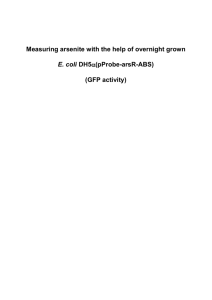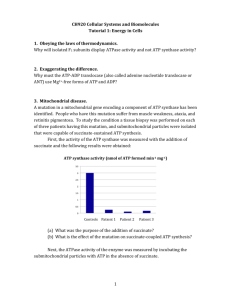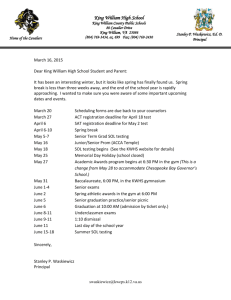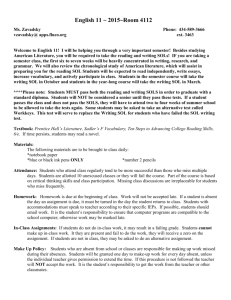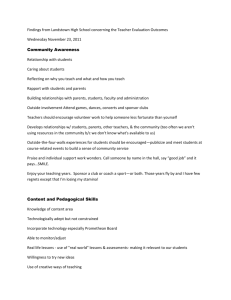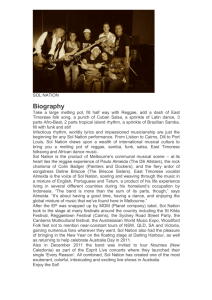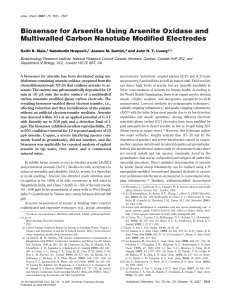Aktivität von Stickstoff-umwandelnde Bakterien
advertisement
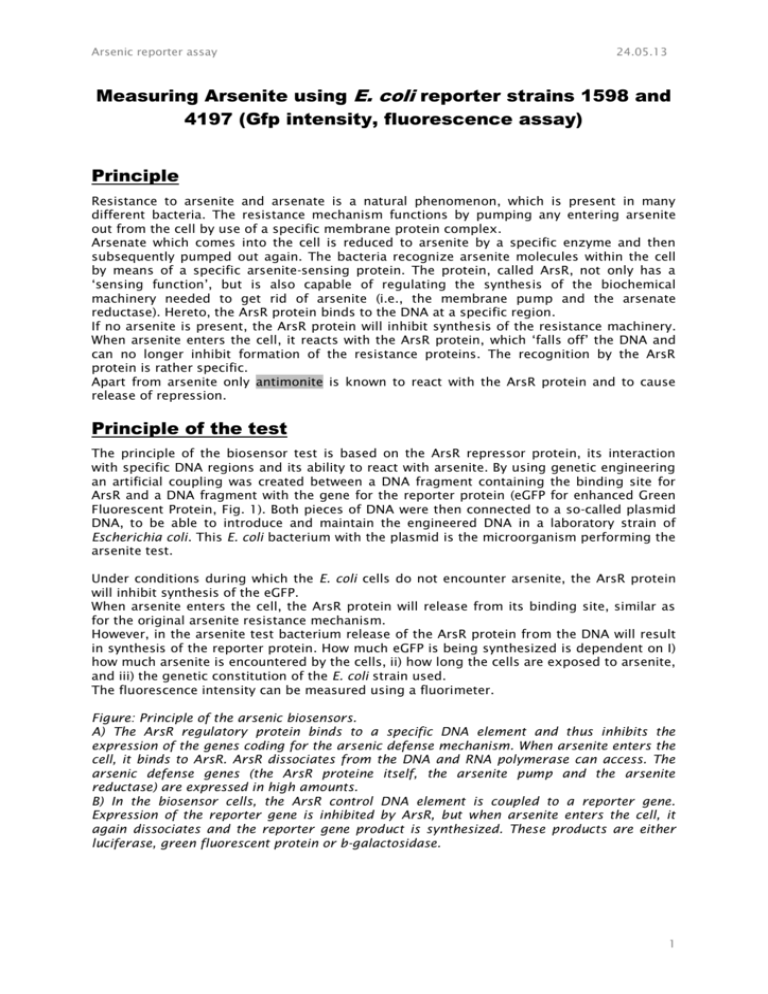
Arsenic reporter assay 24.05.13 Measuring Arsenite using E. coli reporter strains 1598 and 4197 (Gfp intensity, fluorescence assay) Principle Resistance to arsenite and arsenate is a natural phenomenon, which is present in many different bacteria. The resistance mechanism functions by pumping any entering arsenite out from the cell by use of a specific membrane protein complex. Arsenate which comes into the cell is reduced to arsenite by a specific enzyme and then subsequently pumped out again. The bacteria recognize arsenite molecules within the cell by means of a specific arsenite-sensing protein. The protein, called ArsR, not only has a ‘sensing function’, but is also capable of regulating the synthesis of the biochemical machinery needed to get rid of arsenite (i.e., the membrane pump and the arsenate reductase). Hereto, the ArsR protein binds to the DNA at a specific region. If no arsenite is present, the ArsR protein will inhibit synthesis of the resistance machinery. When arsenite enters the cell, it reacts with the ArsR protein, which ‘falls off’ the DNA and can no longer inhibit formation of the resistance proteins. The recognition by the ArsR protein is rather specific. Apart from arsenite only antimonite is known to react with the ArsR protein and to cause release of repression. Principle of the test The principle of the biosensor test is based on the ArsR repressor protein, its interaction with specific DNA regions and its ability to react with arsenite. By using genetic engineering an artificial coupling was created between a DNA fragment containing the binding site for ArsR and a DNA fragment with the gene for the reporter protein (eGFP for enhanced Green Fluorescent Protein, Fig. 1). Both pieces of DNA were then connected to a so-called plasmid DNA, to be able to introduce and maintain the engineered DNA in a laboratory strain of Escherichia coli. This E. coli bacterium with the plasmid is the microorganism performing the arsenite test. Under conditions during which the E. coli cells do not encounter arsenite, the ArsR protein will inhibit synthesis of the eGFP. When arsenite enters the cell, the ArsR protein will release from its binding site, similar as for the original arsenite resistance mechanism. However, in the arsenite test bacterium release of the ArsR protein from the DNA will result in synthesis of the reporter protein. How much eGFP is being synthesized is dependent on I) how much arsenite is encountered by the cells, ii) how long the cells are exposed to arsenite, and iii) the genetic constitution of the E. coli strain used. The fluorescence intensity can be measured using a fluorimeter. Figure: Principle of the arsenic biosensors. A) The ArsR regulatory protein binds to a specific DNA element and thus inhibits the expression of the genes coding for the arsenic defense mechanism. When arsenite enters the cell, it binds to ArsR. ArsR dissociates from the DNA and RNA polymerase can access. The arsenic defense genes (the ArsR proteine itself, the arsenite pump and the arsenite reductase) are expressed in high amounts. B) In the biosensor cells, the ArsR control DNA element is coupled to a reporter gene. Expression of the reporter gene is inhibited by ArsR, but when arsenite enters the cell, it again dissociates and the reporter gene product is synthesized. These products are either luciferase, green fluorescent protein or b-galactosidase. 1 Arsenic reporter assay 24.05.13 Material and Solutions 96-well microtiter plates (PS TC sterile black µclear, Greiner Bio One) Fluorimeter FLUOstar Omega (BMG Labtech GmbH, Germany) Thermostar+™ orbital shaker (BMG Labtech GmbH, Germany) Multichannel pipet 20-200 µL (Gilson) Tap water Sterile LB broth MOPS working solution (MOPS buffer 1X; 2 mM of MgCl2; 0.1 mM of CaCl2; 0.2% of glucose). MOPS buffer, 10X stock solution (per liter: 5 g of NaCl, 10 g of NH4Cl, 98.4 g of MOPS, 0.59 g of Na2HPO4x2H2O, 0.45 g of KH2PO4, pH 7.0) Arsenite stock solutions dissolved in tap water. Procedure - Grow Escherichia coli DH5α cells over night in 10 ml LB medium with 50 µg/ml kanamycine for 16 h at 30°C, 180 rpm. - Prepare a 50-fold dilution of the overnight culture at stationary phase: 200 µl in 10 ml of LB + antibiotic (Km50). - Incubate at 37°C and 180 rpm for 2 h (OD600 of ≈0.4-0.6). - Centrifuge for 10 min at 3'000 rpm and replace the medium by MOPS working solution. - Add 150 μl of cell suspension in 96-well microtiter plate, triplicates per calibration. - Make a triplicate calibration series with 0, 4, 7, 10, 30, 50, 75 and 100 μg/L final arsenite concentration by pipetting 50 μl of 4-fold concentrated arsenite calibration solutions to the assay wells, or 50 μl of water as negative control. - Incubate plate at 30°C with shaking at 500 rpm on orbital shaker for 3 h. - Record fluorescence and absorbance (at 600 nm), after 2h and 3h. - Plot (in Excel) fluorescence as function of arsenite concentration and calculate the arsenite (-equivalent) concentration in the samples. 2 Arsenic reporter assay 24.05.13 Results are presented as the induction coefficients, which are defined as the relative fluorescence units (RFU) of the induced samples divided by that of the untreated sample (background fluorescence) after xh incubation. Stock solutions preparation: Molar mass of As = 74.9216 g/mol 1000 mM/50 mM = 20 => 74.9216/20 = 3.746 g/L In sodium arsenite stock solution NaAsO2 50 mM (Merck), 3.746 g As(III)/L To get a final stock concentration of 100 mg/L, and 10 µl from NaAsO2 50 mM stock: 3'746 mg/L * 10 µl = 100 mg/L * V2 => V2 = 374.6 µl => 10 µl NaAsO2 50 mM + 364.6 µl H2O solution 1 (AsIII 100 mg/L): 10 µl NaAsO2 50 mM (stock sol.) + 364.5 µl H2O solution 2 (AsIII 10 mg/L): 100 µl sol. 1 + 900 µl H2O solution 3 (AsIII 1 mg/L): 100 µl sol. 2 + 900 µl H2O 0 µg As(III)/L: 1.5 ml of H2O 4x 4 µg As(III)/L: 24 µl sol 3 + 1.476 ml of H2O 4x 7 µg As(III)/L: 42 µl sol 3 + 1.458 ml of H2O 4x 10 µg As(III)/L: 60 µl sol 3 + 1.440 ml of H2O 4x 30 µg As(III)/L: 18 µl sol 2 + 1.482 ml of H2O 4x 50 µg As(III)/L: 30 µl sol 2 + 1.470 ml of H2O 4x 75 µg As(III)/L: 45 µl sol 2 + 1.455 ml of H2O 4x 100 µg As(III)/L: 60 µl sol 2 + 1.440 ml of H2O solution 2 (AsIII 10 mg/L): 100 µl sol. 1 + 900 µl 0.9% NaCl solution 3 (AsIII 1 mg/L): 100 µl sol. 2 + 900 µl 0.9% NaCl 0 µg As(III)/L: 1.5 ml of 0.9% NaCl 4x 4 µg As(III)/L: 24 µl sol 3 + 1.476 ml of 0.9% NaCl 4x 7 µg As(III)/L: 42 µl sol 3 + 1.458 ml of 0.9% NaCl 4x 10 µg As(III)/L: 60 µl sol 3 + 1.440 ml of 0.9% NaCl 4x 30 µg As(III)/L: 18 µl sol 2 + 1.482 ml of 0.9% NaCl 4x 50 µg As(III)/L: 30 µl sol 2 + 1.470 ml of 0.9% NaCl 4x 75 µg As(III)/L: 45 µl sol 2 + 1.455 ml of 0.9% NaCl 4x 100 µg As(III)/L: 60 µl sol 2 + 1.440 ml of 0.9% NaCl 3 Arsenic reporter assay 24.05.13 1598 0.9% NaCl As(III) µg/ml 0 4 7 10 30 50 75 100 A B C D E F G H 4197 0.9% NaCl 1 2 3 4 5 6 0 0 0 0 0 0 4 4 4 4 4 4 7 7 7 7 7 10 10 10 10 30 30 30 50 50 75 100 Tap water 7 8 1598 ddH2O 9 10 11 12 1598 0 0 0 4197 4 4 4 7 7 7 7 10 10 10 10 10 30 30 30 30 30 30 50 50 50 50 50 50 50 75 75 75 75 75 75 75 75 100 100 100 100 100 100 100 100 4
